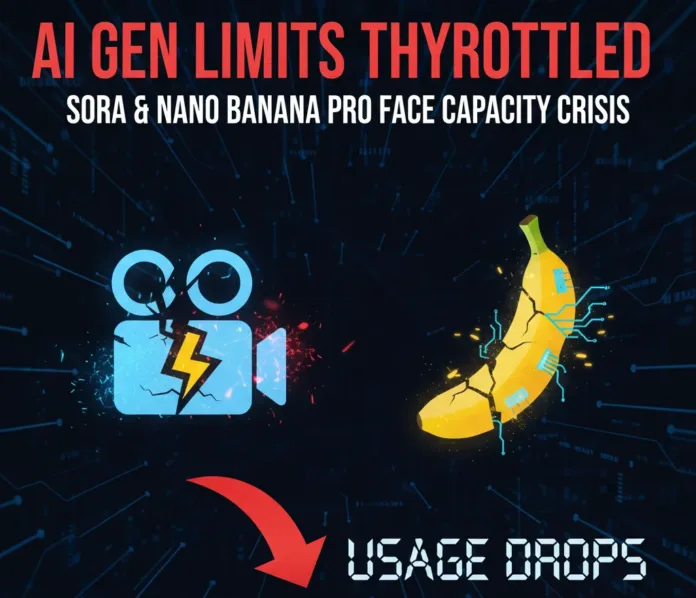Table of Contents
Sora and Nano Banana Pro throttled their generation limits this week, and the move has already sparked wide discussion across the AI community. These tools are used by millions of users who rely on fast visual and video generation during peak periods, especially during holiday weeks when creative activity spikes. The recent decision by Google and OpenAI to reduce free generation allowances gives us a clear view into capacity pressure, consumer behavior, and the new direction of platform monetization.
Why Sora and Nano Banana Pro Throttled Their Limits
The most direct reason why Sora and Nano Banana Pro throttled their generation caps is increased demand. Both Google and OpenAI confirmed that usage volume far exceeded what their current GPU capacity could support at normal speeds. During holiday periods, more users experiment with AI tools, share generated content, and push platforms to their peak.
Read more on our article, Nano Banana Pro: The Gemini 3 Pro That Changes AI Images, published on November 21st, 2025, SquaredTech.
Google and OpenAI rely on GPU clusters that run large generative models at scale. These clusters must handle millions of requests. When user activity enters extreme volume zones, the generation queue grows. Every request involves a large amount of compute power, especially for video models. This pressure forces companies to slow access for free tiers so they can maintain stability.
OpenAI’s Sora team leader, Bill Peebles, gave a direct explanation. He stated that free users can now produce six video generations per day. His comment that “our gpus are melting” reflects how demand has reached levels that strain hardware. While phrased casually, the statement signals a real engineering challenge. Video models are expensive to run because they must process many frames and maintain motion consistency. This leads to higher GPU consumption compared to still-image or text models.
Google confirmed a similar experience. Nano Banana Pro users now face a reduction in free image generations, dropping from three to two per day. Google did not release a detailed technical explanation, but the platform message referenced high demand and the need for rapid adjustment during early release periods. Both companies have a long history of adjusting limits during spikes, and the current pattern fits that trend.
A Look at the Broader Technical Context Behind the Limits
The fact that Sora and Nano Banana Pro throttled their services is not surprising to engineers who work with large models. Many video and image systems run on GPUs that must support complex operations. Scaling them overnight is very difficult. Adding more hardware is expensive. Training and inference pipelines sometimes need re-architecture before they can meet long-term demand. These factors create a fragile balance between growth and stability.
When a major AI model launches or receives a major update, attention rises rapidly. Social media posts showcase the model’s creative output, which encourages more people to test it. Video content is especially viral. Short clips generated by Sora spread quickly across platforms like YouTube, TikTok, and X. Each viral example increases new traffic, which further strains capacity.
This explains why Sora and Nano Banana Pro throttled their limits during a holiday period. Users had more free time. They created more content. They pushed systems to their limits. Companies chose protective restrictions instead of letting platforms slow or crash.
How Sora and Nano Banana Pro Throttled Free User Access
OpenAI and Google approached the throttling process differently, but both aimed to protect core performance while managing rising user activity.
OpenAI’s Adjustments for Sora
OpenAI cut the free tier to six video generations per day. The change drew attention because earlier limits had been described as temporary, but this time Peebles did not specify any timeline for future changes. Instead, he encouraged users to purchase additional generations. This aligns with OpenAI’s recent push to convert free users into paying customers.
Paid tiers like ChatGPT Plus and ChatGPT Pro did not see new restrictions. OpenAI did not disclose updated exact limits for these tiers, but users in those plans continue to receive higher generation capacity. This structure incentivizes free users to upgrade if they want consistent access during peak periods.
Because Sora and Nano Banana Pro throttled their limits at the same time, analysts believe the industry is entering a new phase where video generation becomes a major revenue driver. Video models have higher compute costs than text models, making them ideal for monetization.
Google’s Adjustments for Nano Banana Pro
Google reduced free image generations from three to two per day on Nano Banana Pro. This is a new tool, introduced only one week before the throttle. The limit was first observed by 9to5Google and then confirmed inside the product.
Google posted a message saying limits can shift without notice. This is common during early product phases. AI model demand is unpredictable during launch waves, so teams must adjust capacity allocation quickly.
Google also appears to be limiting access to Gemini 3 Pro for some free users. This suggests Google is strengthening its focus on premium AI subscriptions. As more companies shift to revenue-oriented AI ecosystems, free tiers may continue to shrink.
What This Means for AI Users and the Future of Generative Models

The fact that Sora and Nano Banana Pro throttled their services raises important questions for both creators and platform analysts. SquaredTech breaks down the implications into several areas.
1. Free AI Access is Becoming Less Reliable
The trend is clear. Free users face the most aggressive throttling. Free tiers depend on surplus GPU capacity. When demand spikes, companies move that capacity to paid users. The current limits show that the industry is entering a phase where free access may shrink even more.
2. Monetization is Now a Central Strategy
OpenAI’s statement that users “can purchase additional gens as needed” signals a direct shift in business strategy. Video generation is expensive. It cannot be offered at full capacity to millions of free users. Monetization ensures GPU resources are prioritized for paying customers and commercial partners.
Google’s messaging also suggests a shift to subscription priority. As more premium AI bundles gain traction, companies will push free users to upgrade if they want consistent access.
3. GPU Shortages Are Influencing Consumer Experience
The phrase “our gpus are melting” may be casual, but it reflects industry-wide pressure. GPU supply remains tight. Training new models and running inference for millions of people require massive hardware investment. Even companies with deep budgets feel this pressure.
As a result, AI products will continue to throttle during surges until hardware supply expands or new optimization methods reduce GPU load.
4. Viral AI Content Plays a Major Role in Platform Stress
Sora video clips spread rapidly. Nano Banana Pro images drive high engagement. Viral content accelerates demand spikes. This creates sudden waves of traffic that exceed predictions. Companies must react quickly, often by lowering limits for free users.
As AI creativity becomes part of social culture, bursts of viral usage may become a normal pattern.
5. The Industry Is Moving Toward Prioritized Access
Paid users continue to enjoy consistent generation capacity. They receive faster queues, higher limits, and stable access even during peak traffic. This suggests that long-term AI access will involve clear separation between free and premium experiences.
In short, the fact that Sora and Nano Banana Pro throttled their limits signals a major transition toward structured access.
Final Outlook on Why Sora and Nano Banana Pro Throttled Access
SquaredTech sees the recent throttling of Sora and Nano Banana Pro as a strategic and technical response to a surge in usage that exceeded available capacity. The high demand exposed how expensive and resource-intensive video and image generation have become. It also highlighted the growing shift toward paid access and subscription models.
As adoption increases, AI companies will adapt with stronger incentives for paid tiers, more dynamic limits, and faster monetization cycles. Users should expect fluctuations during peak periods until platforms expand hardware capacity or introduce new optimization techniques.
Stay Updated: Artificial Intelligence


